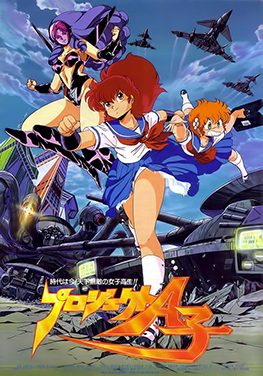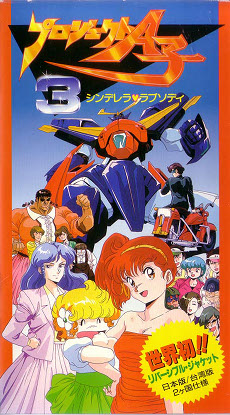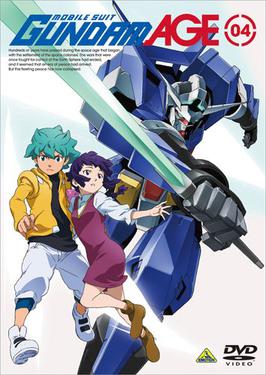
Magic Knight Rayearth is a Japanese manga series created by CLAMP. Appearing as a serial in the manga magazine Nakayoshi from the November 1993 issue to the February 1995 issue,the chapters of Magic Knight Rayearth were collected into three bound volumes by Kodansha. They were published from July 1994 to March 1995. A sequel was serialized in the same manga magazine from the March 1995 issue to the April 1996 issue. It was published by Kodansha in three bound volumes from July 1995 to April 1996.

Magical Girl Pretty Sammy is a Japanese original video animation (OVA) series produced by AIC and Pioneer LDC,and released from 1995 to 1997 as three videos. It features character Sasami from the Tenchi Muyo! series as a magical girl,and is noted for recasting the Tenchi Muyo! characters in new roles. It has been dubbed into English by Pioneer USA. It also spawned two television series - Magical Project S,and Sasami:Magical Girls Club.

Project A-ko is a 1986 Japanese animated science fiction action comedy film. The film focuses on 16-year-old Japanese teenage schoolgirl A-ko,who defends her best friend C-ko,as they face off against their fellow classmate and rival B-ko while the Earth faces the threat of an alien invasion. It was directed by Katsuhiko Nishijima with Yuji Moriyama did animation direction and character design. The film project initially started as part of the Cream Lemon series of original video animation,but later became its own film. The film staff said they were motivated to produce a fun exciting film in contrast to the more serious anime films being produced at the time. Additionally,the film includes a variety of references and parodies a number of other works of anime from the 1970s and 1980s.

Sonic the Hedgehog or Sonic the Hedgehog the Movie,is a two-part 1996 Japanese original video animation (OVA) based on the video game franchise by Sega. Produced by Pierrot and directed by Kazutaka Ikegami,it was released in Japan on January 26,1996 and March 22,1996.

Tenchi Muyo! GXP is a Japanese anime television series animated by AIC and broadcast on NTV from April 3,2002 to September 25,2002. It is the fourth installment of the Tenchi Muyo! line of series,succeeding Tenchi in Tokyo,localized in North America by Funimation. On November 11,2012,it began airing on Adult Swim's revived Toonami programming block. An anime OVA project titled Tenchi Muyo! GXP Paradise Shidō-hen by AIC and Saber Project premiered in May 2023.

Gunbuster,known in Japan as Top o Nerae!,is a Japanese OVA anime series produced by Bandai Visual,Victor,and Gainax and released from 1988 to 1989. It was the directorial debut of Hideaki Anno,best known as the creator and director of Neon Genesis Evangelion. The title is a combination of the titles of classic tennis manga and anime Aim for the Ace! and hit action drama film Top Gun,whose plot inspired Gunbuster's. To celebrate Gainax's 20th anniversary in 2004,a sequel to Gunbuster,Diebuster,was released as an OVA. The sequel features new characters and mecha,but retains the format and many of the concepts of the original series.

Dirty Pair is a series of Japanese light novels written by Haruka Takachiho and illustrated by Yoshikazu Yasuhiko that was later adapted into anime and manga versions. The first stories that make up the first volume were first published on the S-F Magazine. The franchise has been published in multiple formats,and adapted into various other media,resulting in eight novels and several shorter stories,a television series,two OVA series,two OVA features,a feature film,a number of graphic novels,and two short Japanese radio series. The 1985 television series won the Animage Anime Grand Prix prize for that year.

The Galaxy Railways is a Japanese anime television series produced by Leiji Matsumoto,creator of Galaxy Express 999,and is about flying trains set in the far reaches of outer space. It began airing on October 4,2003. Funimation licensed the anime for release in the United States. It debuted on American TV in a syndicated Funimation Channel programming block airing on CoLours TV on Monday,June 19,2006. The series has also aired on the linear Funimation Channel. Two sequels have been produced,both currently unlicensed in English regions.

Pani Poni,also known by the title of its anime adaptation,Pani Poni Dash!,is a Japanese manga series by Hekiru Hikawa that uses parody,frequently referencing Japanese and American pop-culture in many ways. It mainly follows child prodigy Rebecca Miyamoto,an MIT graduate newly hired as a homeroom teacher at Peach Moon Academy,where she deals with the antics of the Class 1-C students during everyday school life. The manga was serialized in Square Enix's G Fantasy between the November 2000 and October 2011 issues,and the chapters are collected in 17 tankōbon volumes.

Toku is an American pay television network and streaming service owned by Olympusat and dedicated to broadcasting anime and East Asian programming.

Space Pirate Captain Harlock is a Japanese manga series written and illustrated by Leiji Matsumoto. It was serialized in Akita Shoten's Play Comic from January 1977 to June 1979,with the chapters collected into five tankōbon volumes. The series follows the titular Captain,an outcast who has turned into a space pirate to rebel against Earth's government and humanity's general apathy.

Tenchi Muyo! Ryo-Ohki,known as simply Tenchi Muyo! in North America,is a collection of Japanese OVAs created by Masaki Kajishima and animated by AIC. Initially released in 1992,it marked the beginning of the Tenchi Muyo! franchise,composed of several manga,OVAs,TV series,and other related media. The first two OVA series were later licensed and distributed in North America by Pioneer Entertainment,with Funimation taking over the rights for the third series,and later taking over the rights for the first two OVAs. In 2020,Crunchyroll acquired worldwide streaming rights for the fourth and fifth seasons of the OVA.

Project A-ko 2:The Plot of the Daitokuji Financial Group is a 1987 Japanese anime OVA release directed by Yuji Moriyama. It is the sequel to the 1986 theatrical release Project A-ko.

Project A-ko 3:Cinderella Rhapsody is a 1988 Japanese anime OVA release directed by Yuji Moriyama. It is the third installment of the Project A-ko series.

Project A-ko 4:Final is a 1989 Japanese anime OVA release directed by Yuji Moriyama. It is the fourth installment of the Project A-ko series.

Black Rock Shooter,often stylized as Black★Rock Shooter,is a Japanese media franchise based on independent character illustrations created by artist Ryohei Fuke,also known as Huke. It revolves around its eponymous character,a mysterious black haired girl with a blazing blue eye. The original illustration inspired a song of the same name by Supercell featuring the Vocaloid Hatsune Miku,which gained popularity on the Nico Nico Douga website.

Dragon Ball Z Side Story:Plan to Eradicate the Saiyans is a 1993 card battle role-playing game developed by Tose and published by Bandai for the Family Computer game console. Based on the Dragon Ball franchise,the player's movement and battle choices are dictated by randomly generated playing cards.

Mobile Suit Gundam AGE is a 2011 Japanese science fiction anime television series and the twelfth installment in Sunrise's long-running Gundam franchise. The series was first announced in the July issue of Shogakukan's CoroCoro Comic,and has gaming company Level-5's President Akihiro Hino in charge of the story.

Voltron is a 1984 American-Japanese animated television series produced by World Events Productions for a total of 124 episodes. The series is an adaptation of the Japanese super robot anime series Beast King Go-Lion,which was dubbed into English and edited to create Voltron episodes. Later episodes also use footage from the mecha anime Armored Fleet Dairugger XV.



















